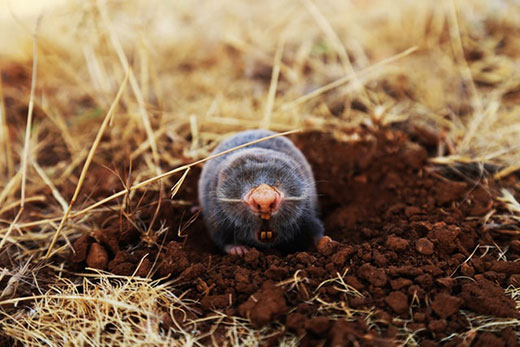
Moles mostly move below ground, but the damage they cause above ground can be significant.
Mole trouble? Traps are the most effective way to save your yard
K-State horticulture expert shares tips for trapping moles
April 15, 2021
MANHATTAN, Kan. – Considering the fact that moles spend most of their time underground, they sure cause quite a mess above the ground.
Kansas State University horticulture expert Ward Upham said the surest signs that homeowners have of moles in their yard are the meandering paths or tunnels of upheaved soil, caused by the small mammals foraging for food.
“Some tunnels may be abandoned soon after being built, while others are travel lanes and are used for a longer period of time,” Upham said. “If the soil is dry, moles form mounds of soil (as they search for food), but do not make the meandering paths,”
The result is a traffic-way of lines in the home lawn and other parts of the yard that soon cause soft sections that crumble under foot. That can cause a problem for lawns, in particular, because even though moles don’t feed on plant matter, their movements disrupt roots and uproot small plants.
“The best control method for moles is the use of traps,” Upham said, noting there are three types of traps (harpoon, choker and scissor-jawed) but each takes some time to master.
“Moles use some tunnels more than others,” Upham said. “Use a broomstick or something similar to poke holes in a number of runs. Check a day later to see which runs have been repaired. These are the active runs that should be used to place traps.”
In an active run, Upham suggests excavating the soil, placing the trap and then replacing loose soil. “Secure the trap so that the recoil will not lift the trap out of the ground,” he said. “Make sure the triggering mechanism is in the center of the run.”
To help ensure success, push down two holes on each side of the trap. “Moles should be caught when they try to repair the tunnel,” Upham said. “Move the traps if moles are not caught within three days.”
Aside from traps, Upham said numerous home remedies to control moles have been tried, including chewing gum, noise makers, broken glass, bleaches, windmills and human hair. “None have been found to provide consistent and reliable control,” he said.
“Poison baits also fail to work because moles feed on earthworms and grubs, not vegetable matter,” Upham said. “Even grub control products are ineffective because they do not control earthworms, which are the primary food source for moles.”
More information including examples of how to track an active mole tunnel and set a trap are shown in videos available online from the K-State Research and Extension wildlife management program.
In addition, Upham and his colleagues in K-State’s Department of Horticulture and Natural Resources produce a weekly Horticulture Newsletter with tips for maintaining home landscapes. The newsletter is available to view online or can be delivered by email each week.
Interested persons can also send their garden- and yard-related questions to Upham at wupham@ksu.edu, or contact your local K-State Research and Extension office.

